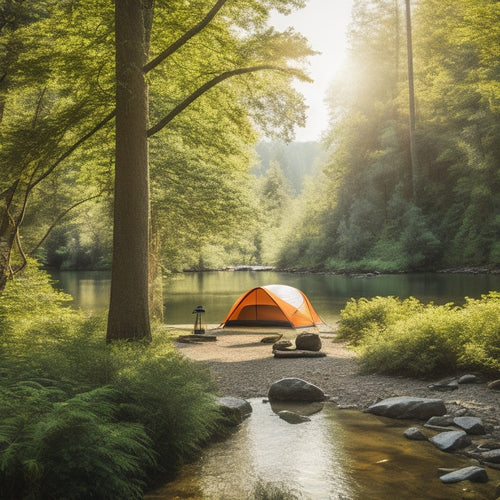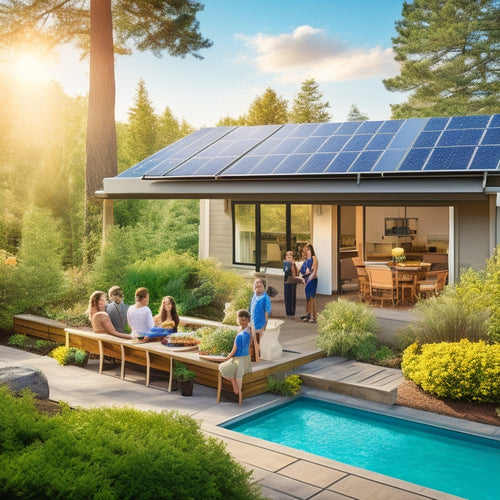
Top Travel Solar Panel Tips for Beginners
Share
When you're picking a travel solar panel, focus on compact and lightweight designs for easy transport. Consider your power needs—charge your phone with smaller panels or opt for larger ones for laptops. Aim for high-efficiency materials, like monocrystalline, to maximize energy output. Make sure your panel can handle your devices and supports USB or other connections. Finally, place your panel in direct sunlight and adjust its angle throughout the day for ideal energy capture. With these tips in hand, you'll enjoy reliable power while exploring the great outdoors and uncover even more essential advice for your excursions.
At a Glance
- Choose lightweight and compact solar panels to ensure easy transport and setup during your travels.
- Assess your energy needs by calculating the total wattage of devices you plan to charge.
- Opt for high-efficiency materials like monocrystalline for optimal energy output in limited space.
- Look for panels with portable features, such as built-in handles or foldable designs, for added convenience.
- Position your solar panels directly under sunlight and tilt them towards the sun for maximum energy capture.
Compact and Lightweight Design
When you're on the go, portability is key, and that's where compact and lightweight solar panels shine.
With an ultra-light design tipping the scales at as little as 3.9 oz, you can easily carry them in your backpack without feeling burdened.
Choosing the right size guarantees you get the power you need without extra bulk weighing you down.
Ideal panel size should fit within standard carry-on luggage dimensions, allowing you to effortlessly utilize solar energy wherever your journeys take you.
Importance of Portability
In your quest for the perfect travel solar panel, portability becomes an essential factor that can make or break your outdoor excursions. You want a solar panel that's compact and lightweight, allowing you to move freely without being weighed down.
When you're out exploring nature, lugging around heavy gear can seriously dampen your experience. A portable solar panel lets you utilize the sun's energy without sacrificing your mobility.
Look for solar panel features that emphasize a slim profile and reduced weight. These panels should fold easily or come with built-in handles, making setup a breeze.
You'll appreciate the convenience of a travel energy solution that fits snugly in your backpack or even clips onto your gear.
Imagine setting up your solar panel at a scenic overlook, effortlessly charging your devices while soaking in the breathtaking views.
With a portable design, you can chase experiences without the hassle of cumbersome equipment. It's all about embracing the freedom to roam, knowing you have a reliable source of power wherever you go.
Prioritize portability when choosing your travel solar panel, and you'll enhance your outdoor experiences considerably.
Choosing the Right Size
Finding the right size for your travel solar panel is vital, as even a compact design can greatly affect your excursions. When you're on the go, you want a solar panel that's lightweight and easy to carry, ensuring it doesn't weigh you down.
Consider various solar panel types, such as foldable or portable units, which allow you to maximize your energy output without sacrificing space.
To choose the perfect size, think about your power needs. If you're charging small devices like phones or cameras, a smaller panel might suffice. However, for larger electronics, you'll want something that can deliver more wattage.
Installation tips play an important role here—opt for a design that's quick to set up and easy to adjust. A compact design means less hassle and more time to discover.
Always remember that the right solar panel can enhance your sense of freedom on the road. With the ability to utilize the sun, you're not tied to traditional power sources, allowing you to venture further and stay off-grid longer.
Welcome the expedition, and choose wisely!
Cost-effective Energy Solution
When you're on the road, finding budget-friendly solar panel options can make all the difference in your travel expenses.
Many travelers opt for solar power banks, which provide a reliable and portable energy source, allowing you to charge devices without the need for wall outlets. Not only do these panels save you money upfront, but they also offer long-term savings by reducing reliance on traditional power sources.
Embracing solar energy means you can enjoy your journeys without worrying about skyrocketing energy costs.
Consider features like ideal capacities and rugged designs to guarantee you select the best option for your travels.
Budget-friendly Panel Options
Choosing the right solar panel for your travels doesn't have to break the bank. There are plenty of affordable brands that provide high-quality options without sacrificing performance. When you're on the road, you want a panel that's lightweight, easy to set up, and efficient at converting sunlight into energy.
Look for portable solar panels that fit your lifestyle, whether you're camping in the wilderness or parked at a beachside. Consider brands known for their budget-friendly models, like Renogy or ALLPOWERS, which offer great functionality without hefty price tags.
Additionally, pay attention to the solar warranties they provide; a solid warranty can protect your investment and guarantee you're covered if any issues arise.
Don't overlook the importance of versatility in your solar panel choice. Many affordable options come with features like foldability or built-in USB ports, making them perfect for charging devices on the go.
With the right budget-friendly panel, you'll enjoy the freedom of utilizing solar energy wherever your journeys take you, knowing you made a smart choice without breaking your travel budget.
Long-term Savings Potential
Investing in a solar panel for your travels not only enhances your outdoor experience but also offers significant long-term savings.
Envision this: you're on a road trip, parked in a breathtaking location, and your solar panel is silently converting sunlight into energy, powering your devices without a care in the world. This freedom from traditional energy sources means you can save money over time, especially when you're frequently off the grid.
The secret to maximizing your savings lies in understanding solar panel longevity. With proper care, your panel can last for decades, providing reliable energy for countless journeys.
Regular cleaning is one of the best maintenance tips—keeping the panels free of dirt and debris guarantees peak efficiency. Also, check the connections periodically to prevent wear and tear.
Key Specifications Overview
When choosing a travel solar panel, you'll want to focus on power output requirements and how they align with your energy needs.
Regular monitoring of battery capacity and guaranteeing proper maintenance, such as battery water maintenance, can greatly enhance your solar power experience.
Equally important are the weight and portability factors, as you'll need a panel that's easy to carry on your excursions.
Understanding these specifications guarantees you find the perfect balance between efficiency and convenience.
Power Output Requirements
Understanding power output requirements is crucial for selecting the right solar panel for your travels. The first step is to assess your energy needs. Think about the devices you'll be charging—your phone, laptop, or maybe a portable fridge. Each device has a different power requirement, measured in watts. By knowing the total wattage you need, you can choose a solar panel that satisfies those demands.
Next, consider the various solar panel types available, such as monocrystalline, polycrystalline, and thin-film. Each type offers different efficiencies and power outputs, which can affect your charging options. Monocrystalline panels, for instance, are known for their high efficiency, making them ideal for limited space while providing more power in less sunlight.
Don't forget about compatibility, too. Verify the solar panel you choose can connect to your devices or battery systems seamlessly. That way, you can stay connected and powered up, no matter where your journeys take you.
Weight and Portability Factors
After determining your power output requirements, it's time to reflect on weight and portability factors, which are essential for any travel setup.
When you're on the go, carrying bulky gear can quickly become a burden, so aim for lightweight options. Look for solar panel materials like monocrystalline, which offer high efficiency with less weight, perfect for maximizing portability.
You'll want to assess the size of the solar panels when folded or packed. Compact designs that can easily fit in a backpack or suitcase are ideal.
Additionally, pay attention to how they're configured—some panels come with built-in handles or straps for easy transport.
Travel charging solutions should also be user-friendly. Opt for panels that set up quickly and don't require complicated assembly.
This way, you can focus on enjoying your excursions rather than wrestling with your gear.
Assess Your Power Requirements
Before hitting the road, you need to calculate your energy needs to guarantee your solar panel setup meets your demands. This includes understanding the total wattage of appliances you plan to use, which aids in determining your power requirements.
Think about the devices you'll be using—are they compatible with your solar panel's output? Knowing both your power requirements and device compatibility will help you choose the right solar solution for your travels.
For more detailed guidance, consider battery bank design to optimize your energy storage.
Calculate Energy Needs
When planning your solar-powered excursions, calculating your energy needs is crucial for guaranteeing you have enough power for your devices. Start by identifying the devices you'll be using and their energy consumption. This way, you can choose the right solar charging setup for your expeditions.
Here's a simple breakdown of common devices and their energy needs:
| Device | Energy Consumption (Watt-Hours per Day) |
|---|---|
| Smartphone | 10 |
| Laptop | 50 |
| Portable Fridge | 120 |
| Camera | 5 |
Add up the watt-hours for all your devices to get a total. For instance, if you're using a smartphone, laptop, and portable fridge, your daily energy consumption would be 10 + 50 + 120 = 180 watt-hours.
Once you know your total energy consumption, choose solar panels that can provide at least that amount daily. This calculation guarantees you won't run out of power when you're out exploring. With the right setup, you'll have the freedom to roam, knowing you can keep your devices charged and ready for any journey!
Identify Device Compatibility
Understanding your devices' compatibility with solar power systems is crucial for maximizing your energy efficiency. Before you hit the road, take a moment to assess what devices you'll be taking with you.
Different solar panel types come with various charging methods, so knowing your devices' power needs will help you choose the right setup.
Start by checking the voltage and wattage requirements of your gadgets. Laptops, cameras, and phones often have different charging needs, and some may require specific solar panel outputs to function properly. For example, many portable solar panels can charge USB devices, while larger panels may be necessary for laptops.
Once you've identified your devices, consider the types of solar panels available. Some are designed for lightweight travel, while others pack more power but can be bulkier. If you're planning to camp or spend time off the grid, a foldable solar panel can be an excellent choice for portability.
Ultimately, matching your devices with the right solar panel types and charging methods will guarantee you stay charged up and ready for an outing, allowing you to investigate freely without worrying about power.
Higher Efficiency Under Sunlight
To get the most out of your travel solar panels, ideal placement is key.
Positioning your panels directly under the sun can greatly enhance their efficiency, ensuring you utilize every ray of sunlight.
Optimal Panel Placement
Positioning your solar panels correctly can greatly enhance their efficiency under sunlight. To maximize energy capture, focus on panel orientation. Ideally, tilt your panels toward the sun's path, which varies based on your location and the time of year. A south-facing angle often yields the best results in the northern hemisphere, while a north-facing direction shines in the south.
Shadow management is equally vital. Even a small shadow can diminish your panels' output considerably. Before you set up, scout your surroundings for potential obstructions like trees, buildings, or other structures that might cast shadows during peak sun hours.
If possible, adjust your placement or trim back foliage to guarantee your panels bask in unfiltered sunlight.
Consider using portable mounts or adjustable racks that let you change the angle throughout the day. This flexibility can lead to considerable energy gains, especially if you're on the move.
With the right orientation and shadow management, you'll utilize the sun's power more effectively, fueling your expeditions and embracing your desire for freedom. Enjoy the experience, knowing your energy needs are met sustainably!
Frequently Asked Questions
How Do I Properly Maintain My Travel Solar Panel?
To maintain your travel solar panel, regularly clean it using gentle techniques like microfiber cloths. This enhances performance optimization, ensuring you utilize maximum energy. Keep it shaded during extreme heat to prolong its lifespan and efficiency.
Can I Use a Solar Panel in Cloudy Weather?
Yes, you can use a solar panel in cloudy weather, but its solar efficiency decreases. Don't let the weather conditions discourage you; even diffused sunlight can generate power, giving you freedom on your excursions.
What Accessories Do I Need for My Solar Panel?
You'll need essential accessories to maximize your solar panel's potential. Think solar panel types, like portable or foldable, and don't forget charging options, such as adapters and batteries, ensuring you're always ready for exploration.
Are There Limitations on Solar Panel Usage While Camping?
Yes, there're limitations on solar panel usage while camping. Factors like weather and sunlight affect solar panel efficiency. Proper camping power management guarantees you maximize energy, keeping your devices charged and your excursions uninterrupted.
How Do I Safely Store My Solar Panel When Not in Use?
Did you know that properly storing your solar panel can increase its lifespan by up to 30%? For solar panel security, keep it in a cool, dry place, ideally in its original packaging to guarantee longevity.
Explore More
Incorporating solar panels into your travel gear can change your escapades. Did you know that portable solar panels can convert up to 23% of sunlight into usable energy? This incredible efficiency means you can power your devices while reducing your carbon footprint. By choosing a compact, cost-effective solar solution customized to your power needs, you'll not only stay connected but also welcome sustainable travel. So, gear up, hit the road, and let the sun power your expedition!
Related Posts
-

Top Eco-Friendly Camping Equipment for a Sustainable Adventure
When you're camping with the planet in mind, opt for eco-friendly gear like tents made from recycled materials and bi...
-

What Do I Need to Know About Farm Solar Panels
When considering farm solar panels, you need to assess costs, benefits, and technical specifics. Initial investment c...
-

Top-Rated Home Solar Power Kits for Achieving Energy Independence
Top-rated home solar power kits enable you to achieve energy independence by greatly cutting your energy costs. You c...


